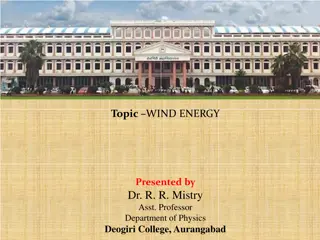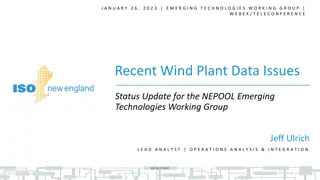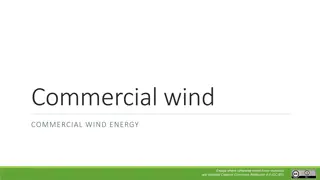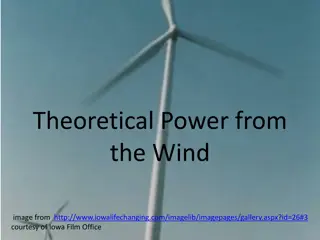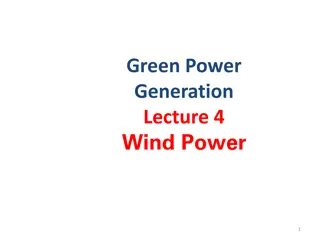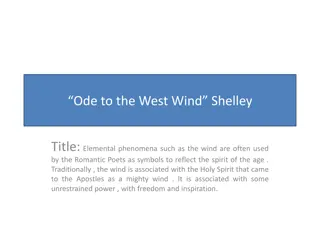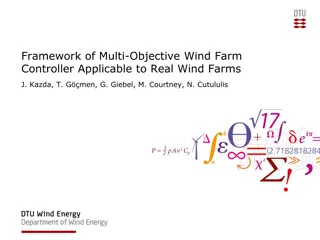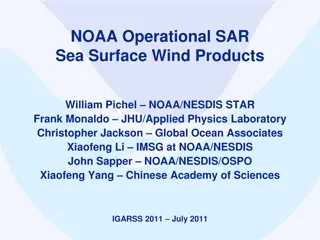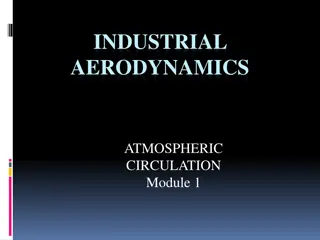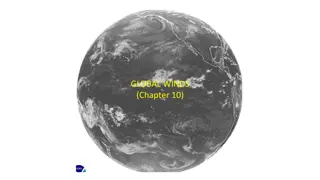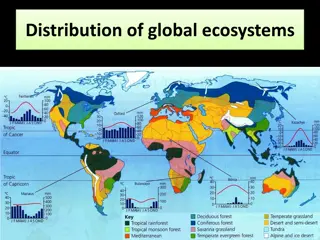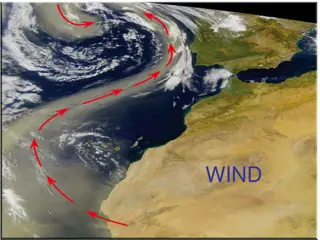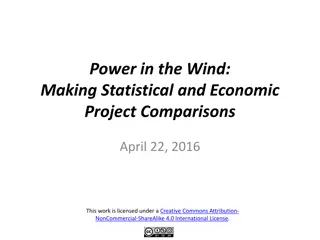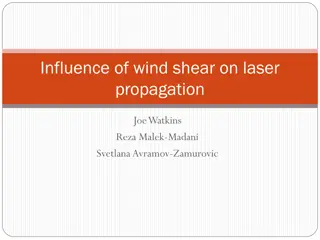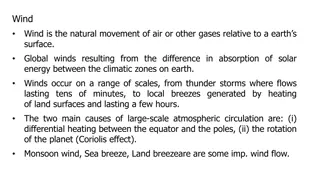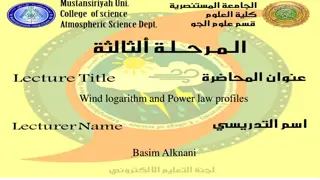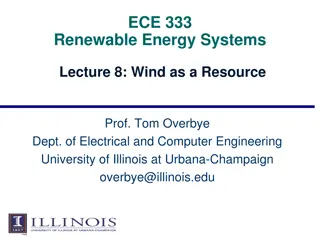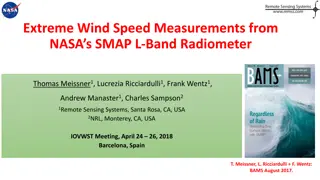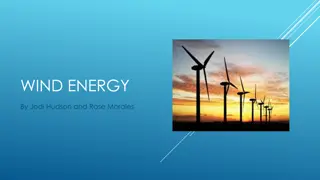Atmospheric Circulation and Wind Patterns
Learn about atmospheric circulation, local winds, terrain types, mean velocity profiles, and different types of winds such as prevailing winds, periodic winds, and local winds. Explore the concept of planetary winds like Trade Winds and Westerly Winds, and understand how winds create air currents. Dive into the intricate system of air movement and wind dynamics in the atmosphere.
Download Presentation

Please find below an Image/Link to download the presentation.
The content on the website is provided AS IS for your information and personal use only. It may not be sold, licensed, or shared on other websites without obtaining consent from the author.If you encounter any issues during the download, it is possible that the publisher has removed the file from their server.
You are allowed to download the files provided on this website for personal or commercial use, subject to the condition that they are used lawfully. All files are the property of their respective owners.
The content on the website is provided AS IS for your information and personal use only. It may not be sold, licensed, or shared on other websites without obtaining consent from the author.
E N D
Presentation Transcript
Syllabus- Module I Atmospheric circulation Local winds- Terrain types Mean velocity profiles Power law and logarithm law-wind speeds
AIR MOVEMENT AIR CIRCULATION WIND CURRENT
The horizontal movement of air along the earth s surface is called a wind The vertical movement of the air is known as an air current. Winds and air current together comprise a system of circulation in the atmosphere.
TYPES OF WINDS 1. Prevailing wind/ Permanent wind/ Planetary wind 2. Periodic wind 3. Local wind
I. Planetary Winds: There are three main planetary winds that constantly blow in the same direction all around the world. They are also called prevailing or permanent winds. 1.Trade Winds: Blow from the subtropical high pressure belt towards the Equator. They are called the north-east trades in the northern hemisphere and south-east trades in the southern hemisphere.
2.Westerly winds: Blow from the same subtropical high pressure belts, towards 60 S and 60 N latitude. They are called the sought Westerly wind sin the northern hemisphere and North Westerly winds in the southern hemispheres. 3.Polar Winds Blow from the polar high pressure to the sub polar low pressure area. In the northern hemisphere, their direction is from the north-east. In the southern hemisphere, they blow from the south-east.
II.Periodic Winds These winds are known to blow for a certain time in a certain direction - it may be for a part of a day or a particular season of the year. Example 1: Land and Sea breeze During the day, near an ocean, sea or lake, the land heats up faster than the water. The air above the land also gets heated. As warm air rises, it draws cooler air from over the water to blow towards the land, creating a sea breeze. At night, the opposite conditions prevail. The land loses heat rapidly while the sea is still warm. The air resting over the land is cold while the air resting over the sea is warm and rises creating a low pressure area.
A land breeze thus blows in from the high pressure over the land towards the water. These land and sea breezes maintain air circulation in the coastal areas and have a moderating effect on the temperatures.
Example 2: Monsoons They are land and sea breezes on a large scale. The word monsoon comes from the Arabic word mausim meaning weather. They change or reverse their directions according to the seasons. Strong contrasts in temperature between summer and winter because great differences in pressure conditions over the interior parts of the big continents like Asia. Hence winds blow onshore from a sea to the land in summer and from land to the sea in winter. The onshore winds bring moisture and heavy rainfall while the offshore winds are relatively dry.
Although the monsoons are associated with south-east USA, Australia, parts of South America and East Africa they are most effective over south-east Asia and India blows from June to September while the winter monsoons prevails from October to December.
Example 3: Mountain and Valley Breezes (tertiary circulation) During the day, the valley heats up, so the warm less dense air flows up the mountain, creating a valley breeze.
At night, the mountain will cool off faster than the valley, so the cool mountain air descends because it is more dense, creating a mountain breeze.
III. Local Winds On the earth s surface, some local variations of temperature on the land may cause changes in air pressure as a result local winds blow. They blow in a particular season and are known by the local names in that region. For instance, the hot dry, dusty winds that blow in the month of May and June over the northern plains in India are called Loo. Some other examples of local winds that bring unusual changes in the temperature of the places are the warm Chinooks that devour the snow on the leeward side of the Rocky mountains of North America, the Foehn in the Swiss Alps and the hot, sand laden Siocco that blows over Southern Europe from the Sahara and causes blood rain which is actually desert sand and dust that falls with the rain.
There are still other types of winds that are irregular and keep changing their direction and blow in an area for a very short time, such as tornadoes, typhoons and cyclones.
CAUSES OF VARIATION OF WINDS The movement and the speed of wind are affected by three main factors 1. Pressure Gradient Force The change in pressure measured across a given distance is called a "pressure gradient". The pressure gradient results in a net force that is directed from high to low pressure. The magnitude of the force depends on 1) How great the pressure difference is between the high pressure area and low pressure area 2) how far apart the two pressure areas are from each other. A large difference in pressure combined with pressure areas that are close to each other will cause a huge pressure gradient which produces a strong wind
2. Coriolis Effect The Coriolis Effect (also called the Coriolis force) is defined as the apparent deflection of objects (such as airplanes, wind, missiles, and ocean currents) moving in a straight path relative to the earth's surface. If the Earth did not rotate upon its axis, winds would follow the direction of the pressure gradient. But the rotation produces another force other than the pressure force. It is called the Coriolis force . Causes air to move in a curved path It is caused by the Earth spinning on its axis The Earth spins fastest at the equator, and slowest near the poles As air moves from the equator to the pole, it will travel east faster than the land beneath it causing the air to follow a curved path
So the Coriolis effect causes wind flowing from high pressure to low pressure to curve as the wind moves In the Northern Hemisphere, the Coriolis effect causes things to curve to the Right In the Southern Hemisphere, the Coriolis effect causes things to curve to the Left
3. Friction The surface of the Earth exerts a frictional drag on the air blowing just above it. This friction can act to change the wind's direction and slow it down -- keeping it from blowing as fast as the wind aloft. Actually, the difference in terrain conditions directly affects how much friction is exerted. For example, a calm ocean surface is pretty smooth, so the wind blowing over it does not move up, down, and around any features. By contrast, hills and forests force the wind to slow down and/or change direction much more.








